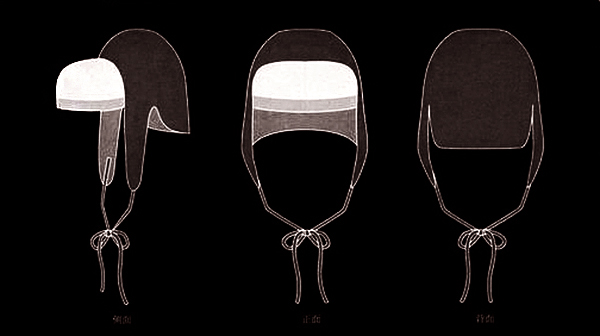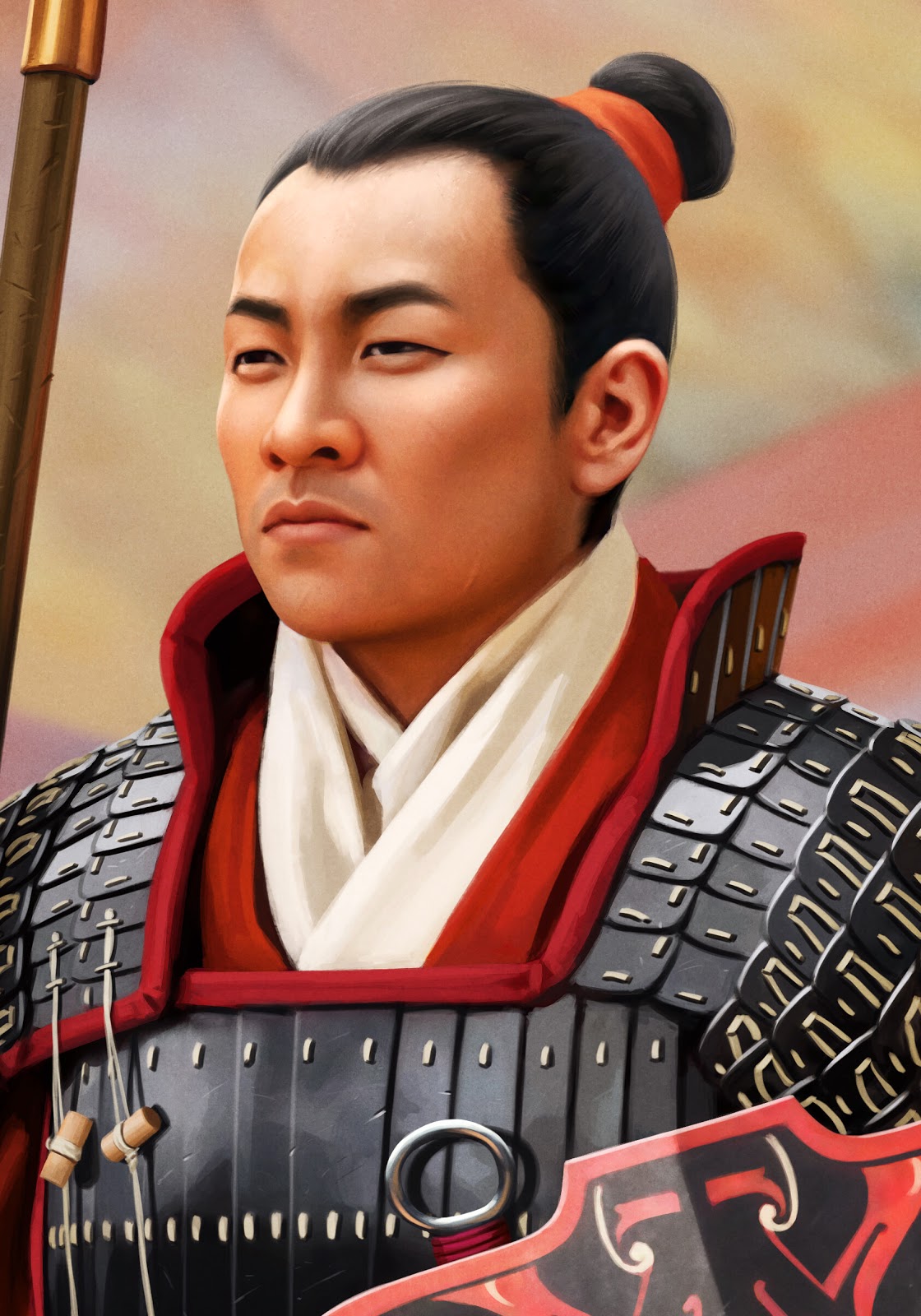Western Han Dynasty Infantryman: 西汉步兵
An unhelmeted Western Han dynasty infantryman in 襟领铠 Jīn lǐng kǎi, "Collared" lamellar armor with extended lamellar pauldrons. He holds a trident called sha (铩) which features large winged lugs on its two sides. On his left hand he holds an ornately painted lacquered shield.
Behind his shield, a Huán shǒudāo (环首刀) lit "Ringed Pommeled Blade," a straight, single-edged guardless dao with a ring-pommel is fastened to his belt with a scabbard buckle. The Han warred extensively with the Xiongnus in what is today's western China. Per the nature of these wars, the soldier is depicted standing before the backdrop of the iconic rainbow striped mountain in what is today's Zhangye Danxia Park.
Above: Huán shǒudāo (环首刀) lit "Ringed Pommel Blade," a straight, single-edged guardless dao with a ring-pommel. Below: .Sha (铩) - Han dynasty tridents. The polearm features large- in this case bronze winged lugs on its two sides. On his left hand he holds an ornately painted lacquered shield.
50 YEARS OF WAR UNDER THE WARRIOR EMPEROR
A ruthless but also ruthlessly efficient autocrat. Han Wudi, or Emperor Wu of Han's long reign lasted a remarkable 54 years- a record not broken until the reign of the Kangxi Emperor more than 1,800 years later and remains the record for ethnic Han Emperors. During his tenure, the Han state went from a respected but still restrained power to the foremost one in East Asia.
His half century of aggressive expansions in all directions resulted in the Han effectively doubling its size. At its height, the Empire's borders spanned from the Tarim Basin and the Fergana Valley in the west, to central Korea in the east, and to northern Vietnam in the south. His posthumous honorific: "Wu" 武 ~ (Literally Translated as the "Martial One" or the "Warrior") by his successors, was attributed in regards to his vigorous campaigns.
In due course, Wu's half century of campaigns would not only force many confrontation with the powerful Xiongnu Confederation but also push the Han to expand in all of its directions. Thus, an inextricably linked legacy of a stern warrior king and his long wars was formed.

Han tomb relief depicting wars between Han soldiers and Xiongnu horse archers. Han soldiers are distinguished by their dotted scale armor surcoat while the Xiongnu are marked by their distinctive conical cap and recurved bow.
NU~ THE CROSSBOW "弩 "
A weapon that is not featured here is the almost ubiquitous Han dynasty crossbow. The crossbow was extensively deployed the the previous Qin dynasty and later Warring States's polities. During the Han dynasty the crossbow was widely equipped by its soldiers.
Realizing that the Xiongnu were poorly equipped to be on the defensive and cannot easily replenish their own slain soldiers, Emperor Wu used the Han Great Walls as his line of projection beyond the north. From these walls, he stockpiled for the long campaigns. The army would be well supplied for a long expedition. The core Han infantry would be supported with massed crossbowmen. For protection, many mounted crossbowmen were deployed in support of the infantry forces. In the Western Han period, these served as the majority of Han cavalry.



Above: a Han dynasty infantry sighting a target using the marker on the back of the metal crossbow trigger. Below: Han dynasty relief depicting a Han mounted crossbow man with Hand crossbow (Shou Nu/ 手弩) pursuing a Xiongnu warrior firing backward from his saddle.
Unlike bowmenship, which takes a life time to perfect, the crossbow as well as its trigger mechanisms are very easy to use by even the simplest of peasants. The Han archers were overwhelmingly crossbowmen. In one of the Han Dynasty armament records (《武库永始四年兵车器集簿》) there were 520000 crossbows in the arsenal, but only 70000 bows. Bolts were numbered over 11 million.
Varieties of Han crossbows include the standard infantry crossbow called Qiang Nu (强弩) "Strong Crossbow." A more long ranged infantry variant was called Jue Zhang Nu(蹶张弩), or “Spanned-By-The-Feet Crossbow” which must be drawn with the aid of the soldier's leg. Cavalry use smaller hand crossbow (Shou Nu/ 手弩) "Hand Crossbow" or the “擎张弩”, which literally means “Spanned-By-The-Arms crossbow”.

Heavy chariots were also deployed in the Han columns. Although they were beginning to be phased at this point, in the wide flat expanse of the steppes these heavy chariots/ and supply carts could form lines of defensive barriers to protect the Han soldiers from Xiongnu volleys and charges. Thus arrayed, the Han attacked the Xiongnu on many campaigns.
2 Reconstructed suits of Han dynasty armor. Han dynasty armors are frequently attached to pauldrons. The heavier armors have a full armored sleeve to protect against the usually vulnerable armpits of the lamellar wearer. Many Han armors, such as the 襟领铠 Jīn lǐng kǎi, "Collared" lamellar armor also have raised back and side collars to protect against glancing sword slashes towards the wearer's neck.
HELMETS
Western Han Helmet. Many helmets during the Western Han period had lamellar helmets that protects the front of the wearer's forehead and cheeks but leaves the dome of the head exposed. Behind this rigid metallic shell, another layer of protective leather helmet is worn over the hair (and topknot) of the head- similar to a 19th century leather American football helmet. Because the Western Han frequently engaged with arrow- firing steppe nomads on horseback, these helmets proved both cheap to make and also adequately protected the wearer.

Simple Western Han helmet that's constructed from a sheet made of lamellar scales. It wrapped around the wearer's forehead and provided protection to his ears. It is secured around the back of the wearer's head as well as knotted under the wearer's chin. The dome of his head is left open, Sometimes a leather cap is worn underneath these helmets.
Protective Han headwear. A leather cap is capped over the soldier's head, providing protection to both his head as well as secured over his tuft of turbaned hair. A cloth then secured over the cap and fastens the helmet on the head through a chin knot.

Above: Han dynasty cavalryman's scale Helmet with jutting pheasant feathers/ A Han cavalryman's leather cap. Below: A Han dynasty cavalryman's leather cap helmet, with jutting pheasant feathers.
Music: A Defiant End
Personal markers: In order for a massive army like that of the Han to function properly in the field, a strict chain of command was established. Elaborate banners and insignia were used to distinguish the many units on the field. Aside from war flags and heraldry that marked whole cohorts, the soldiers were also color-coded with different colored clothing so as to be easily distinguished by commanders. Beyond those, there were even more elaborate visual signifies to mark the soldiers.
Of those (above), soldiers frequently wore the 章 Zhang, or "Badge" that was strapped to their backs which functioned similar to a modern ID badges, and bears the soldier's name, unit, and the name of family members. If the soldier is killed, he can be identified accordingly from the badge, so that he can record and send it to his hometown. This kind of badges can be seen on the Han terracotta warriors and cavalry of Yangjiawan. The second 幡 Fan, which merely meant a draping flag (think long frontally draped prayer flags) these were mainly seen draped over the shoulders among some of the Yangjiawan Terracotta Warriors like a row of long flowing tail-feathers of fowls. However, it is not know what their uses were. Some scholars believe that it either marked a commander or that it marked a messenger.
Lastly, we have the 负羽 Beiyu, or "Back Feathers," these were quite tall and some are half a man's height compared to the figurines. Such prominent markers would doubtless mark the rider on the field. Originally the archaeologists and the historians identified those as crossbow quiver boxes but upon closer scrutiny they discovered that the boxes were designed to have other functions. This is supported by contemporary sources during the Three Kingdoms period.
Thank you to my Patrons who has contributed $10 and above: You made this happen!
➢ ☯ Muramasa
➢ ☯ MK Celahir
➢ ☯ Kevin
➢ ☯ Vincent Ho (FerrumFlos1st)
➢ ☯ BurenErdene Altankhuyag
➢ ☯ Stephen D Rynerson
➢ ☯ Michael Lam
➢ ☯ Peter Hellman
➢ ☯ SunB



















































Comments
According to the historical records of the Sui Dynasty, Emperor Yang of Sui that half of his cavalry wore heavy metal armor while the other half of his heavy cavalry wore leather armor. The Yuan Mongols had a distinctive leather hoop armor(罗圈甲)that were a combined metal/ leather lamellar armor and worn by alot of their heavy cavalry. Do not forget that many Mongol leather armor and boots have small metal plating under them too.
I think the qualifier that there's not much leather armor worn is a HEMA narrative- I've seen HEMA YT commentators saying that a lot and frankly I feel a need to clap back against that.
The tradition of leather armor is also quite abundant across Asia as well. The Yi people, the natives of Yunnan, the Qiang people of Sichuan, and Tibetans frequently had lacquered leather armors. (Google it) Often they are constructed with plates of two layers of water buffalo skin coated in lacquer and paint. They also wore extensive amount of lacquered leather lamellar armors as late as the 20th century into battle.
For me I used Wikipedia as a starting point and then try to go into the sources. Try to find english translated versions of historical records, for Chinese history, almost each dynasty has a historical record that was compiled 1 or 2 dynasties later. Try "Record of the Grand Historian" "Book of Han" "(Old and New) Book of Tang" etc, for armor, go by the era, then by the books that's most cited by credible legit historians and historic authors.
But you are right in regards to the lack of details from the english speaking internet and wikis. Because even supposedly authoritative books from Osprey Publishing etc have ones that's filled with errors, wrong translations and extremely shitting illustrations. Ospray's work on Chinese armor was one of the worst in my memory. And even some of the mostly right and well illustrated artworks by Angus McBride has problems: McBride's Tang armor illustrations- although gorgeous, had many problems like wrong length of leg protection and wrong interpretation from murals etc.
I might recommend if you are researching Chinese or Japanese topics switch to Chinese or Japanese Wiki to see if its more extensive, or scroll down to their citation section and see the books they cited. Use Google translate to see if there's an English translation of it.
You want to copy keywords and they paste it on google to see sources containing the specific reference to an armor or a warrior, battle, dynasty etc. With google translate turned on you can jump onto those pages and read them.
Personally speaking I am not sure how accurate the one from Longest Day in Chang An is, I'm not so sure about how they just dangle everywhere from long strings.
One thing though, The Huán shǒudāo is 环首刀,"Ringed Head(pommel) Blade", for obvious reason.